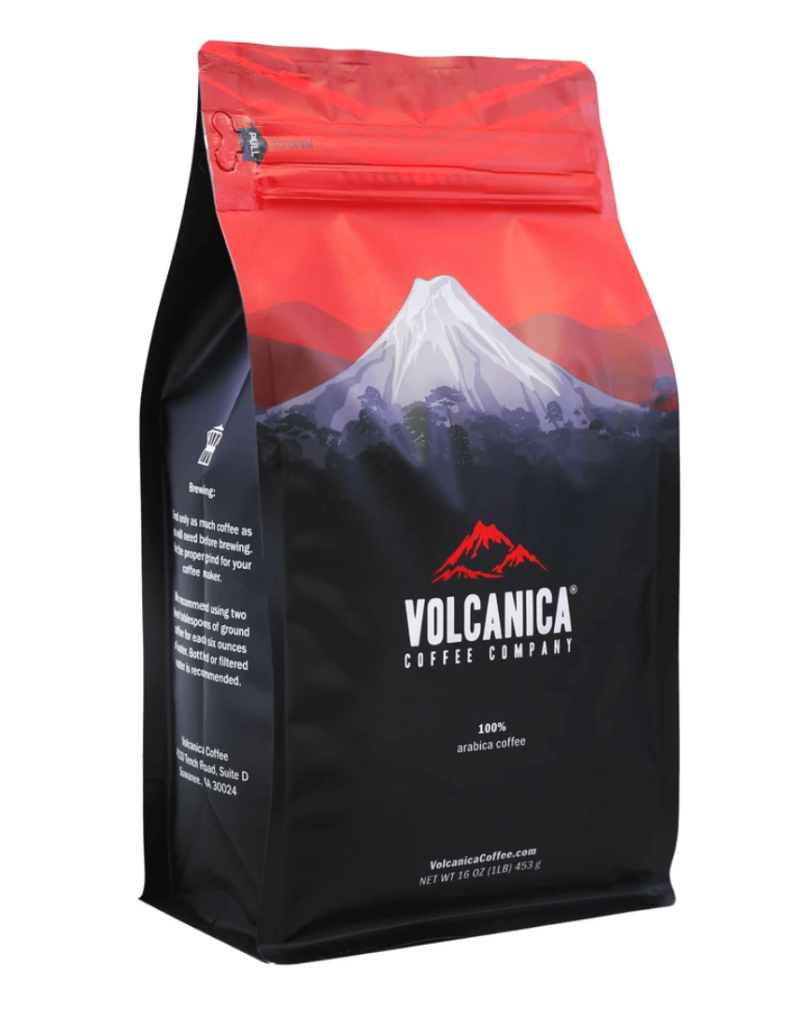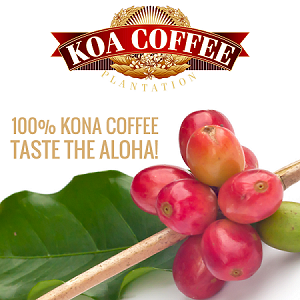If you want the best single-origin or specialty coffee, there’s a good chance you’re going to buy Peruvian coffee beans.
Why’s that?
Well, similar to how France is considered the best region for wine production, many coffee lovers consider Peru the best region for coffee cultivation. It’s all about, soil, climate, altitude, etc.
These factors make Peru the place for high-quality beans!
If you want to know
- the best Peruvian beans on the market,
- what makes Peruvian coffee so good,
- how Peru’s coffee industry developed or
- pretty much anything else about it,
then you’re in the right place!
Let’s jump right in with our recommendation for the best Peruvian coffee beans!
Peruvian Coffee – Top Picks
- Top Pick: Volcanica Tres Cumbres
- For Cold Brew: Cooper’s Cask Peruvian Coffee
- Unique Flavor Profile: Fresh Roasted- Peruvian Coffee
Best Peruvian Coffees
1) Volcanica Tres Cumbres
Volcania Tres Cumbres offers some of the best organic coffee from Peru. These medium-roast beans were grown in the Chanchamayo region high in the Andes.
These Chanchamayo beans have floral notes and the light acidity often associated with Peruvian coffees. And they have the complex sweetness and full-bodied flavor you’d expect from beans grown at high altitudes.
If you want to try some of the best beans around, this ground coffee is definitely worth a try!
2) Fresh Roasted Coffee, Organic Coffee Peru
The Fresh Roasted brand offers certified organic, fair-trade beans from the Cajamarca region of northern Peru.
These are medium roast Peruvian beans that have a wonderful flavor profile that combines spiced cinnamon, sweet caramel, and a mild hint of citrus.
With a flavor profile like that, you can be sure they make a phenomenal cup of coffee!
3) Cooper’s Cask Peruvian Coffee
This Peruvian ground coffee is made specifically for cold brew! They’re organic, fair trade certified, single-origin, and have a delicious flavor!
Cooper’s Peruvian beans are medium roast and combine the traditionally sweet flavor of Peruvian coffee with a slight touch of cherry and orange.
4) Cubico Peru Coffee
Cubico Peru coffee uses high-quality arabica beans that were grown in the northern highlands of Peru. These are medium roast whole beans. And the brew has a smooth body with citrus flavor and toffee sweetness.
This is considered one of the best Peruvian coffee brands available out there.
5) Mt. Comfort Organic Coffee – Peru Blend
With Mt. Comfort’s Peru blend, you get organic whole beans sourced from the Chontalin and Chancahmayo coffee-growing regions in Peru.
With Mt. Comfort’s Peru Blend, you’ll get a smooth cup of coffee that’s a great choice for Peruvian coffee lovers. It’s a well-balanced medium roast with notes of chocolate, nuts, and citrus.
6) First Colony Organic Whole Bean Coffee, Peruvian Andes Gold
These whole bean are certified organic and were grown on the slopes of the Andes.
They’re 100% arabica beans, and like most Peruvian beans they have a rich and complex sweet flavor due to the high elevation.
Peruvian Andes Gold has a medium body and is imbued with caramel, nutty and smoky notes.
All in all, this brand is definitely worth a try!
7) Cafe Altura Whole Bean Dark Roast
Cafe Altura is one of the Peruvian brands that produce organic and non- GMO Coffee. They’re dark roast beans with subtle smoky notes with hints of caramel and cocoa.
These organic whole beans are unique for their bold and flavorful taste.
If you are looking to start your morning with a fulled-bodied cup of joe, this will be right down your alley. You can enjoy this dark roast whether you brew it in a french press, drip maker, or Moka pot.
What Is Peruvian Coffee?
A majority of the coffee grown in Peru is arabica. The country’s high altitudes cause the plants to grow slower, which gives them time to develop the sweet, complex flavors associated with Peruvian coffees.
Peru’s coffee is also mostly cultivated by small family farms, which sets it apart from the mass-produced coffees found in other countries.
Because they’re produced by smaller farms, the beans are highly regarded as single-origin and specialty coffee.
What Does Peruvian Coffee Taste Like?
Peruvian coffee is known for its sweetness, floral notes, and mild acidity. But there are variations in the flavor profile depending on the bean’s origin.
For example, coffee grown in the lower altitude regions of Peru tend to have mild acidity with nutty, fruity, and floral flavor.
On the other hand, Peru’s high-altitude regions produce coffee with even more intense floral notes, bright acidity, and more complex flavor profiles.
In addition to natural regional differences, Peruvian coffees are cultivated on thousands of small coffee farms. Often, these farmers don’t have access to chemical fertilizers, so the beans are organic and maintain much of their natural flavor.
All these factors will affect the taste of your final cup of coffee!

History Of Peruvian Coffee
There’s a bit of mystery surrounding how the first coffee plants arrived in Peru, but we do know it was introduced in the 1700s.
During the 18th and 19th centuries, most Peruvian coffee beans grown were consumed by locals with very little being exported.
European Investment In Peruvian Beans
During the late 1800s, coffee rust devastated the Sri Lankan coffee crop, and the disease quickly spread around Asia.
Since Asia was the main source of coffee for Europe, they had to search for another source to satisfy their coffee fix. This search led them to Peru.
Europeans began investing in Peru’s coffee industry in the early 1900s, causing the industry and its exports to skyrocket.
England also received nearly 5 million acres of Peruvian land as payment for a loan default (that’s another story altogether), which they used to start more coffee plantations.
All these factors caused the Peru coffee industry to explode even more.
Related Posts:
- Best Kona Coffee Brands. What To Know Before Buying!
- Best Low Acid Coffee: 18 Brands You Wish You Knew Sooner!
- Jamaican Blue Mountain Coffee: Worlds Top Coffee!
- African Coffee – 8 Best Coffee Brands To Try!
Peruvian Farmers Gain Control
After World Wars I and II Britain sold its Peruvian land holdings and the land was redistributed among the local farmers.
The small farmers are now independent and in control, but they no longer have the same production and logistic capabilities to get their coffee beans to the international market. This eventually led to the formation of coffee cooperatives (more on that later!)
Even still, Peru is one of the largest producers in the world. And they’re one of the largest exporter of Arabica and fair trade coffee beans in South America.
Shop For Related Products
How do Peruvians Drink Their Coffee?
In Peru, there are two common ways to drink coffee.
- Instant coffee
- Cafe Pasado
Instant Coffee
If you order a regular coffee in Peru, you’ll most likely get a cup of hot water with a jar of instant coffee and sugar on the side.
This surprises a lot of travelers since a huge part of Peru’s economy is growing coffee, but it’s true! If you want something a little more Peruvian, you’ll have to try the cafe pasado.
Cafe Pasado
The pasado is a coffee concentrate. To prepare the coffee, simply get a cup of hot water and add as much coffee concentrate as you’d like.
But how do you make the concentrate? Well, there are two brewing options.
- Cold Brew Pasado
- Hot Brew Pasado
First, you can make a bottle of cold brew and use that for your pasado.
Alternatively, you use a coffee maker that drips boiling water very slowly through ground coffee.
In Peru, this is done with a special brewer called a “Cafetera gota a gota” (a drip coffee maker that looks sort of like a Moka pot.)
Whichever method you choose, you’ll end up with coffee concentrate that can be used to make your pasado.
Coati Coffee (a.k.a. Peruvian Poop Coffee)
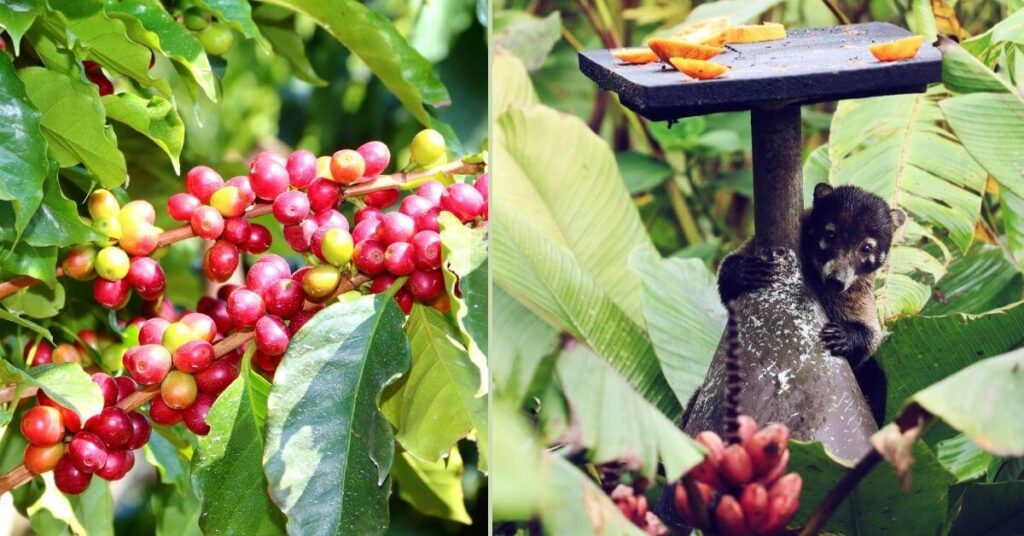
Coati coffee is coffee beans that have been eaten, partially digested, and expelled by the coati (a raccoon-like animal in Peru).
I know how it sounds, but apparently, when the coati eats coffee cherries, the seeds can’t be completely broken down. But the enzymes in the animal’s intestines break down the coffee’s acids and eliminate bitterness.
During their trip through the animal, the coffee beans are also imbued with flavors from other jungle fruit the coati has eaten.
This is definitely the most unique coffee Peru has to offer!
Why Is Coati Coffee Expensive
Coati coffee can only be collected in small amounts. In addition, it has to go through an intense cleaning process before being packaged for consumption.
The limited supply and labor costs mean that every bag comes with a hefty price tag.
Other Poop Coffees
Besides Peruvian poop coffee, there are several other dung coffee varieties.
There’s,
- Black Ivory coffee – coffee beans gathered from the waste of Thai elephants.
- Kopi luwak – made from beans collected from Asian Palm Civets (a cat-like creature)
- Jacu Bird Coffee – made from beans collected from the Jacu Bird of Brazil
The reasoning behind producing these poop coffees is the same as the coati coffee – the digestive process breaks down acids and proteins, which makes a smoother and less bitter coffee.
Related Posts:
- Best Kona Coffee Brands. What To Know Before Buying!
- Best Low Acid Coffee: 18 Brands You Wish You Knew Sooner!
- Jamaican Blue Mountain Coffee: Worlds Top Coffee!
- African Coffee – 8 Best Coffee Brands To Try!
Peruvian Fair Trade Movement
In a nutshell, the Peruvian fair trade movement was started to make sure the farmers got a fair price for their coffee beans.
But before we can talk about fair trade coffee in detail, we need to talk about the problems it was created to solve.
Before Peru’s Fair Trade Movement
For most of the 20th century, Peruvian beans were produced by small, independent coffee farms. Most of these farms were remote and there was little organization between them.
So, after harvesting their coffee (often by hand), each farmer had to travel for miles to the closest town. And when they arrived, there was often just one buyer.
Since there was just one buyer and a ton of sellers, the buyer could buy Peruvian coffee beans at dirt cheap prices. And the farmers suffered for it.
After Peru’s Fair Trade Movement
In the early 2000s, the fair trade movement gained traction in Peru and many farmers became members of cooperatives.
The purpose of these cooperatives is to increase production, logistics and bargaining capabilities. But besides fair trade initiatives, there’s been a large push to produce organic coffee in Peru as well.
If you want to support the farmers in these cooperatives, look for Peruvian coffee labeled “Fair Trade” on the package.
Shop For Fair Trade Products
What Is Cenfrocafe
Cenfrocafe is a coffee cooperative that was founded in 1999. Nowadays it represents over three thousand small farms from the lush Cajamarca region of Peru.
Cenfrocafe’s mission is to contribute to sustainable development in Peru through coffee cultivation.
The cooperative has its own coffee processing plant, a central storage warehouse, and it provides training and technical assistance to its farmer-members.
Related Posts:
- Best Kona Coffee Brands. What To Know Before Buying!
- Best Low Acid Coffee: 18 Brands You Wish You Knew Sooner!
- Jamaican Blue Mountain Coffee: Worlds Top Coffee!
- African Coffee – 8 Best Coffee Brands To Try!
Coffee Regions Of Peru
Peruvian coffee is grown all over the eastern slope of the Andes mountains and is concentrated in three main regions.
- Chanchamayo
- Amazonas
- San Martin
Here’s a quick summary of each region.
Chanchamayo
Chanchamayo is a region on the eastern slopes of the Andes mountains. It’s known for its high altitude and rich soils, which make some of the best coffee beans in Peru.
Amazonas
The Amazonas is located in northern Peru. It’s also a high-altitude region and produces amazing coffee due to the ideal condition to grow coffee there. The beans cultivated have notes of fruit, citrus, and a hint of chocolate.
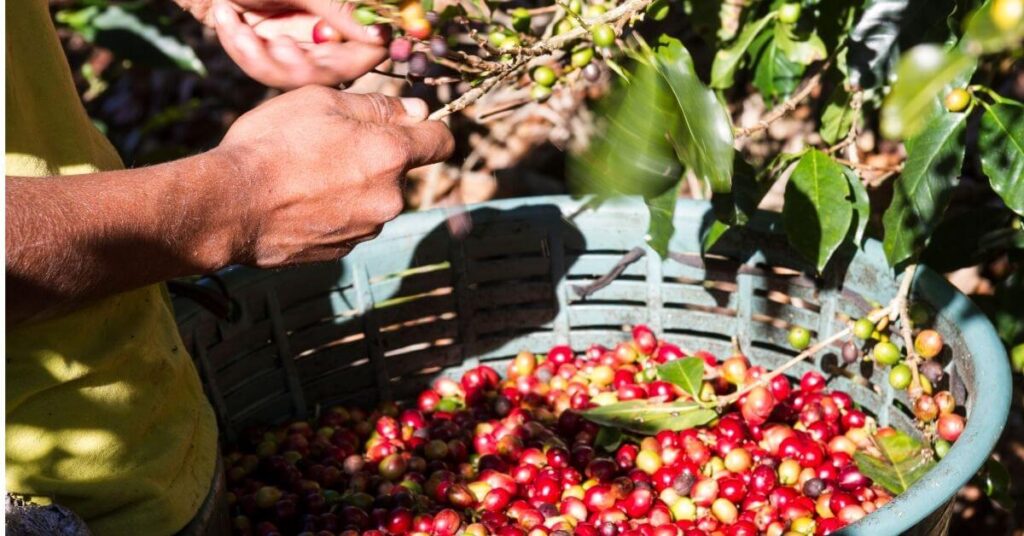
San Martin
Lastly, San Martin produces similar beans to the Amazonas region, however, it’s at a lower altitude. Although this region lacks mechanical and chemical influences, it continues to grow as a coffee producer. The San Martin region also produces a large portion of Peru’s organic beans.
Peru’s Most Popular Coffee-Growing Region
In previous years most Peru coffee was grown in the Chanchamayo Valley, and these beans were considered to be of the highest quality.
But recently, production has been shifting more towards the Amazonas and San Martin regions, because of disease devastating the coffee crop in Chanchamayo.
Future of the Peruvian Coffee Industry
Peru’s coffee industry is made of small farms that produce fair trade, shade-grown, organic, and delicious coffee. But they’ve also been struggling for the past few years. But currently, Peru is considered one of the largest producers in the world.
Peruvian Coffee Environmental Issues
Around 2013 a fungus known as Coffee Leaf Rust arrived and devastated the coffee crop.
Not only that but in 2020 there was a coffee borer beetle infestation that affected several coffee fields.
These environmental issues have wiped out crops, hurt exports and generally put the farmers in a worse position.
Related Posts:
- Best Kona Coffee Brands. What To Know Before Buying!
- Best Low Acid Coffee: 18 Brands You Wish You Knew Sooner!
- Jamaican Blue Mountain Coffee: Worlds Top Coffee!
- African Coffee – 8 Best Coffee Brands To Try!
Peruvian Coffee Financial Issues
Peruvian coffee farmers have also faced a severe economic crisis because of falling coffee prices in the global market coffee.
Because of this, the revenues of the coffee farmers haven’t been enough to cover the costs of production for the last few years.
What’s Next For Peruvian Coffee?
Despite all these issues, coffee production in Peru is beginning to rebound. Partly because of the excellent supply of water and the great coffee-growing conditions.
In addition, international prices are starting to increase, which will allow coffee farmers to invest more in fertilizers and more thorough harvesting.
Shop For Related Products
The Bottom Line – Peruvian Coffee Beans
Because Peruvian coffee is grown in rich soils at very high altitudes, it tends to have a denser and sweeter flavor than coffee grown in other countries.
These characteristics make it highly desired as specialty and single-origin coffee. If that’s down your alley, I’d recommend trying Peruvian coffee brands like Volcanica Tres Combres, Fresh Roasted Coffee, or Cooper’s Cask Peruvian coffee.
And if you’re a serious coffee aficionado, why not try single-origin coffees from Peru’s different regions.
If you haven’t tried Peruvian coffee already, it’s definitely worth a shot! If you have, let us know about the best Peruvian coffee you’ve tried in the comments below!
Cheers Coffee Lovers!

KEEP READING
- What Are The Best Coffees For Moka Pot Brewing?

- Cafe Bustelo vs Pilon (Which One Should You Choose?)
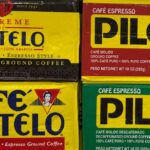
- Is Cafe Bustelo Cuban? (Discovering Its Origins)

- Best Cold Brew Coffee For Intermittent Fasting!


Oliver is co-owner of Coffee Break Lovers. The only thing he loves more than the process of brewing coffee is drinking it.


